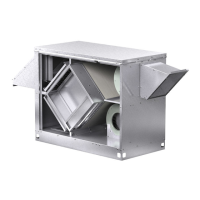Energy Core Ventilator24
®
Always have a completed Pre Start-Up Checklist, unit Start-Up Checklist, and Optional Accessories Checklist prior to
requesting parts or service information.
Symptom Possible Cause Corrective Action
Blower fails
to operate
Blown fuse or open circuit breaker.
Replace fuse or reset circuit breaker and check
amps.
Defective motor or capacitor. Replace.
Motor starter overloaded. Reset starter and check amps.
Electrical.
Check for On/Off switches. Check for correct
supply voltage.
Drive.
Check for broken or loose belts. Tighten loose
pulleys.
Motor starters
“chatter” or
do not pull in
Control power (24 VAC) wiring run is too long
(resistance should not exceed 0.75 ohms).
Shorten wiring run to mechanical room or install a
relay which will turn unit on/off. Consult factory for
relay information.
Incoming supply power is less than anticipated.
Voltage supplied to starter coil must be within
+10% / -15% of nominal voltage stated on the coil.
Need to increase supply power or use a special
control transformer which is sized for the actual
supply power.
Motor over amps
CFM too high. Check cfm and adjust drives if needed.
Static pressures are higher or lower than design.
If higher, ductwork should be improved.
If lower, fan rpm should be lower.
Blower rotation is incorrect. Check rotation and reverse if necessary.
Motor voltage incorrect. Check motor nameplate versus supplied voltage.
Motor horsepower too low.
See specifications and catalog for fan curves to
determine if horsepower is sufficient.
Shorted windings in motor. Replace motor.
Low airflow (cfm)
Unit damper not fully open. Adjust damper linkage or replace damper motor.
System static pressure too high.
Improve ductwork to eliminate losses using good
duct practices.
Blower speed too low. Check for correct drives and rpm with catalog data.
Fan wheels are operating backwards.
For 3-phase, see Direction of Fan Wheel Rotation
under Unit Start-Up section.
Dirty filter or energy core.
Follow cleaning procedures in Routine Maintenance
section.
Leaks in ductwork. Repair.
Elbows or other obstructions may be obstructing
fan outlet.
Correct or improve ductwork.
Belt slippage. Adjust belt tension.
High airflow (cfm)
Blower fan speed too high.
Check for correct fan rpm. Decrease fan speed if
necessary.
Filter(s) not in place. Install filters.
Insufficient static pressure (Ps) (airflow resistance).
Induce Ps into system ductwork. Make sure grilles
and access doors are installed. Decrease fan speed
if necessary.
One or both
blowers turn off
intermittently and
back on after
about 2 minutes
Frost control sensors are tripping.
Adjust frost temperature sensor set point as
needed.
Troubleshooting – Unit

